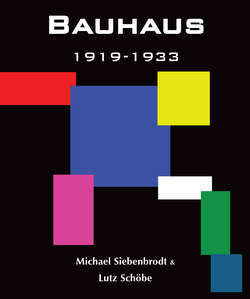Читать книгу Bauhaus. 1919-1933 - Michael Siebenbrodt - Страница 2
На сайте Литреса книга снята с продажи.
Preface
ОглавлениеThe Bauhaus was one of the most important and momentous cultural manifestations of the twentieth century. There is no doubt about it. It is more than ever a phenomenon of global dimensions. Today, the Bauhaus is embedded in the public consciousness; it is held in high esteem and, depending on one’s interests, occasionally glorified or denounced. But recognition and positive esteem are prevalent. The work of the Bauhaus artists enjoys universal admiration and interest in the great museums of the world. Their creative theories, if often taken out of their complex context, received and continue to receive attention in many renowned architectural and art education institutes, as well as in basic art lessons in education facilities. Bauhaus products – such as Marcel Breuer’s famous tubular steel furniture – proceeded to become highly-traded design classics. Bauhaus buildings, such as the sites in Weimar and Dessau, are considered pieces of architectural history, and today they are part of Germany’s cultural heritage. The Bauhaus went down in art history as the original modernist art school.
Now, almost a century after its foundation, it is still current. This is evident not only in the increased institutional interest in the school’s work, an exhibition boom that hasn’t worn off, and a multitude of new publications and unending media interest, but also in the area of theoretical architectural research, in which investigations into functionalism, a design concept closely connected to the Bauhaus, are on the increase. The creation of a new man for a new, more humane society was the Bauhaus’s true goal. It remains historically unfulfilled. Are we to understand the intervention by philosopher and sociologist Jürgen Habermas regarding “modernism as an unfinished project” in this way, too?
This book limits itself to portraying the history of the Bauhaus in a more or less rough overview. The authors can thus make reference to a multitude of existing publications as well as to their own published writings on the subject. The claim is not to subject the Bauhaus to criticism on principle from a twenty-first century perspective but rather the intention simply to portray what was, in an objective argument of the most important points and with no claim to exhaustiveness, for this book is intended for the interested reader and not the knowledgeable expert. If this leads to the break up of unilateral ways of viewing the Bauhaus, that harmonious, consistent, conflict-free, “progressive” and non-traditional organisaton, the authors will consider themselves lucky.
The portrayal begins with references to the forerunners of the Bauhaus, places it in the context of the events of its time and describes the circumstances leading up to its foundation. In a brief overview, the authors present the internal structure of the school and its individual sites in Weimar, Dessau and Berlin, as well as the conceptions of its three directors, Walter Gropius, Hannes Meyer and Ludwig Mies van der Rohe. The following chapters inform the reader about the teaching and training structure of the Bauhaus and present the teaching concepts of its most important teachers. Attention is given to the Bauhaus workshops, their respective structures, the spectrum of achievements and the modifications by the different directors. These are followed by short chapters on general matters such as architecture, photography and visual arts in the Bauhaus, as well as on life and work at the school. A short overview of the effects and reception of the Bauhaus from its beginnings to the present forms the conclusion.
Special emphasis is placed on promoting the comprehension of connections, consequences, mutual influences and developments in a sequence of selected and matched images. In this way, the reader may have visual access to the Bauhaus through the language of its time.
The appendix, with its compressed chronology summarising the history of the Bauhaus and evoking parallel events in culture, politics, technology and science, allows for individual conclusions and the identification of links and references not included in the text.
A bibliography, with information about the most important literature on the Bauhaus in general, as well as on select topics, offers opportunities for further in-depth study of the subject.
